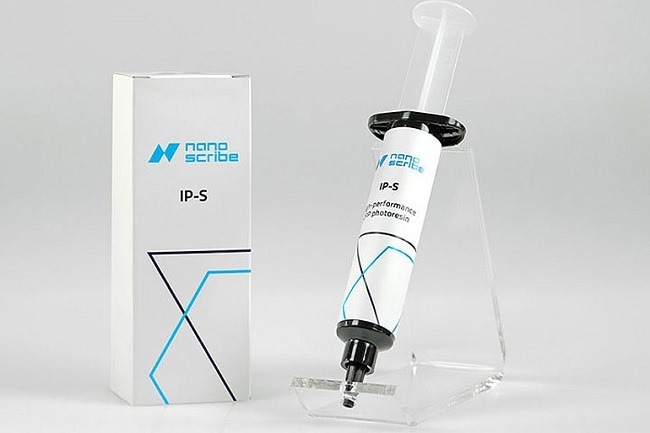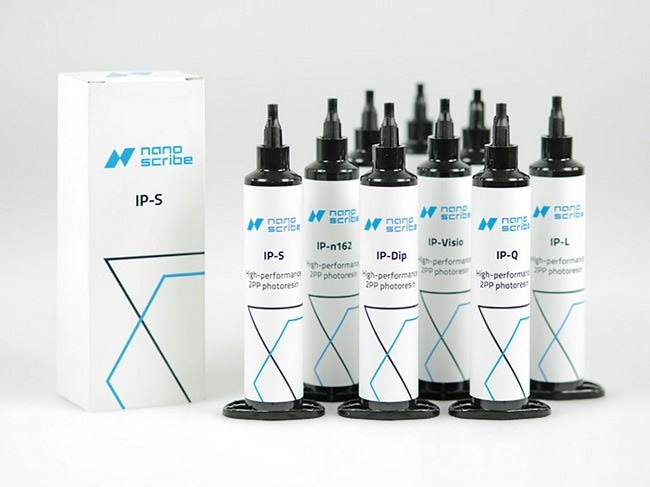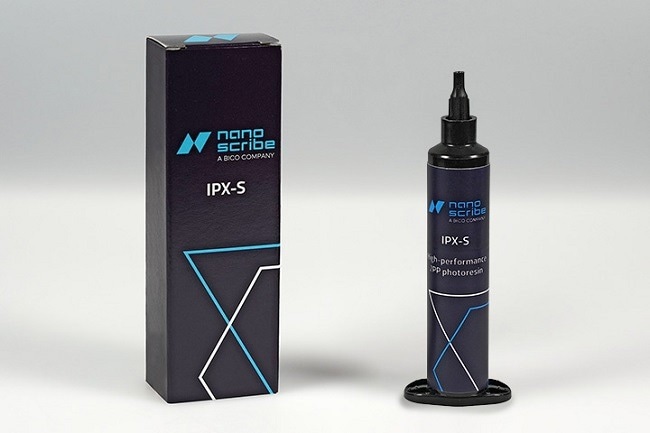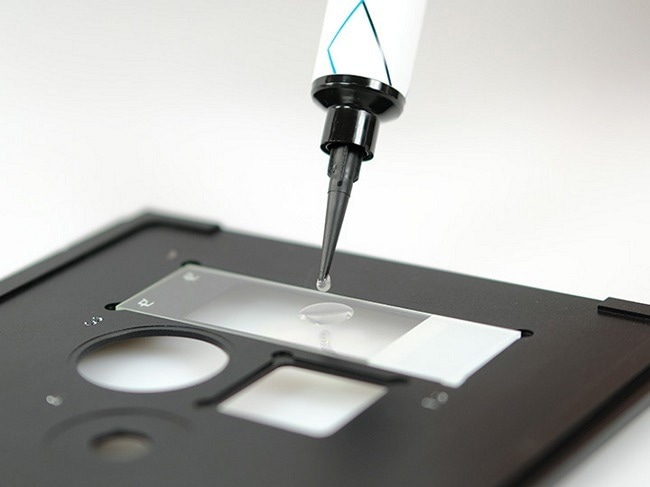Overview
For high-resolution microfabrication, Nanoscribe IP Resins are recognized as standard materials. The key attributes of these negative-tone resins include sub-micrometer resolution, shape accuracy, and ease of handling.
Pick the photoresins that are most appropriate for the applications. Gain from features that are submicron in size, have overhanging parts, optically clear surfaces, can be produced quickly at the mesoscale, are biocompatible, or have a high refractive index.
High-performance printing materials known as IP Resins are a crucial component of Nanoscribe’s Microfabrication Solution Sets. The printer software provides sophisticated recipes that have been modified for various photoresins and applications.
They simplify the 3D printing process and shorten design iteration times for a variety of scientific and commercial use cases, including biomimetic surfaces, microoptical components, mechanical metamaterials, and 3D cell scaffolds.

Image Credit: Nanoscribe
Features
- Cartridges with photoresins that are lightproof and resealable are available
- Take advantage of bubble-free, precise manual dosing or automatic dispensing onto substrates, wafers, chips, and other microparts
- IP Photoresins, a product line of negative-tone resins, is offered. They have outstanding qualities necessary for high-precision additive manufacturing and are optimized for two-photon polymerization (2PP):
- Minimum feature sizes of typ. 160 nm
- High-speed microfabrication
- Excellent adhesion to various substrates
- Optimized mechanical stability and excellent shape accuracy
- Straightforward handling and easy processing
- Neither spin-coating nor post-exposure bake required
- The photoresins are designed to work with the Quantum X maskless lithography system, the Nanoscribe Photonic Professional GT2 3D printer, and the high-performance Quantum X shape 3D printer
Nanoscribe IP Resins are really efficient. With IP-Dip we produce molds for replication, with IP-S micro nozzles. With the Photonic Professional GT, we also use other materials as hydrogels or siloxane.”
Giovanna Brusatin, Professor, University of Padova
Application
IP Photo resins
Table 1. Source: Nanoscribe
| Resin |
Advantages |
Possible applications |
New
IP-PDMS |
2PP printing of soft, flexible and highly elastic structures |
Material engineering, life sciences, cell and tissue engineering, microfluidics, microelectromechanical systems (MEMS) |
New
IP-n162 |
High refractive index material with n=1.62. Photoresin with low absorption in the infrared range. Well suited material for direct printing and prototyping of 2.5D and 3D microstructures. |
Refractive microoptics in 3D and free space microoptics for integrated photonics |
| IP-Visio |
Biocompatible, non-cytotoxic according to ISO 10993-5 / USP 87. Low autofluorescence for cell microscopy. |
Multi-cell scaffolds, tissue engineering, biomedical devices, life sciences |
| IP-Q |
High-speed fabrication of millimeter-sized objects. Designed for Dip-in Laser Lithography (DiLL) |
Biomedical engineering, mechanical components, micro rapid prototyping |
| IP-S |
Biocompatible, non-cytotoxic according to ISO 10993-5 / USP 87. Smooth surfaces for micro- and mesoscale fabrication with optical-quality surface roughness and shape accuracy. Designed for DiLL. |
Mechanical metamaterials, microoptics, integrated photonics, microfluidics, cell scaffolds |
| IP-Dip |
Biocompatibility, non-cytotoxic, evaluated by our customers, partly under stricter requirements than ISO 10993-5. Submicron features and high aspect ratios. Designed for DiLL. |
Photonic metamaterials, diffractive optical elements, microrobots |
| IP-G |
Complex 3D designs, e.g., overhanging elements. Submicron features and low shrinkage. Designed for oil immersion configuration. |
Overhanging elements in biomimetics, photonics, microrobots |
| IP-L |
Biocompatibility, non-cytotoxic, evaluated by our customers, partly under stricter requirements than ISO 10993-5. Submicron features and low shrinkage. Designed for oil immersion configuration. Compatible with DiLL. |
Plasmonics, photonic and biomimetic surfaces |
Nanoscribe IP Resins are available for Nanoscribe systems only. Upon request we also provide the following IP Photoresins without photoinitiator: IP-Dip, IP-S and IP-Q. Contact us for more information.
Specs
Table 2. Source: Nanoscribe
| Properties |
Refractive index 1 @ 589 nm, 20 °C |
Young‘s modulus 1 [GPa] |
Degradation temperature 1 [°C] |
Biocompatibility |
Classification / Print set |
| IP-Q2 |
1.513 |
n/a |
242 |
n/a |
Universal / LF |
| IP-S2 |
1.515 |
5.1 |
286 |
yes |
Universal / MF |
| IP-Dip2 |
1.552 |
4.5 |
371 |
yes |
Universal / SF |
| IP-L |
1.519 |
3.9 |
362 |
yes |
Universal / SF |
| IP-G |
1.515 |
3.4 |
n/a |
n/a |
Sol-gel / SF / MF |
| IP-PDMS |
1.450 |
0.015 |
n/a |
yes |
Functional / MF |
| IP-n162 |
1.622 |
n/a |
n/a |
n/a |
Functional / MF |
| IP-Visio |
1.511 |
n/a |
n/a |
yes |
Functional / MF / LF |
1 measured on 3D printed or UV-cured structures; results depend on the printing conditions and geometry
2 upon request available without photoinitiator
Print Sets: LF – Large feature, MF – Medium feature, SF – Small feature
More materials
- The Nanoscribe microfabrication tools are made as open systems that work with a variety of materials
- Third-party UV-curable photoresists, hydrogels or nanoparticle composite resins, and made-to-order materials are also included in the range of materials

Image Credit: Nanoscribe
- Numerous materials and processes enable optical, mechanical, electrical, chemical, and biological properties to be tuned as necessary, for example in optics, photonics, or biomedical engineering, to satisfy the needs of material developers for testing new resins
- Casting, atomic layer deposition (ALD), chemical vapor deposition (CVD), and galvanization are examples of post-print processes that allow modification of the 3D printed structures and allow the addition of additional materials like ceramics, metals, glass, or other plastics
- Third-party photoresists
- SU-8 – negative-tone, epoxy-based resists
- AZ® photoresists-positive-tone resists
- ORMOCER® polymers-inorganic-organic hybrid polymers
- Custom-made materials
- Hydrogels - e.g., degradable resins
- Composite materials
- Liquid-crystal elastomers
IPX Photoresins for Quantum X systems
- The brand-new IPX Photoresins were created especially for use with Nanoscribe Quantum X systems
- High-precision 2.5D microfabrication and the ground-breaking Two-Photon Grayscale Lithography technology are both available on the platform's industry-proven technology
- For various structure qualities and processes, the new IPX photoresin series of photopolymer printing materials has been created
- The IPX-S and IPX-Q are made to use two-photon grayscale lithography and two-photon polymerization, respectively, to print mesoscale structures with micrometer accuracy

Image Credit: Nanoscribe
Key features of IPX-S
- Rapid 2GL-based 2.5D Microfabrication using GrayScribeX
- Designed for printing with the Quantum X platform
- Printing up to millimeter-scale optics – using the Large Feature Print Set
- Full design freedom for 2.5D structures
- Optical-grade surfaces with roughness down to 10 nm Ra
- Excellent shape accuracy
Key Features of IPX-Q
- Rapid 2PP-based 3D Microfabrication using DeScribeX
- Designed for printing with the Quantum X platform
- Printing up to millimeter-sized 3D objects – using the Large Feature Print Set
- Full design freedom for 3D structures
- High aspect ratios
- Excellent shape accuracy
Precise and clean dispensing of printing materials

Image Credit: Nanoscribe
- Cartridges with light-resistant and resealable photoresins are available. Benefit from precise, bubble-free automatic or convenient manual dosing for application to substrates, wafers, chips, and other microparts. Added benefits include:
- Improved cleanliness
- Better handling and dispensing
- High-yield dispensing